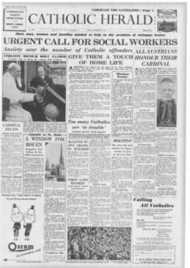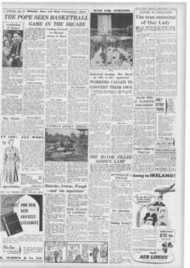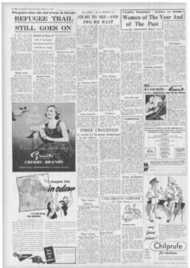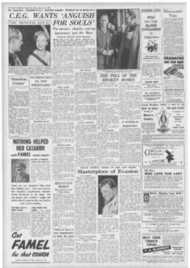Page 1, 14th October 1955
Page 1

Report an error
Noticed an error on this page?If you've noticed an error in this article please click here to report it.
Tags
Share
Related articles
Move Welcomed By Vatican
Papal Legate Calls To Austrians:
The Austrian Bishops Tried To Collaborate "
`where There's Life . .
" Battle Is Raging On Our Borders"
ALL AUSTRIANS HONOUR THEIR CARDINAL
ALL over newly liberated Austria this week black flags have been flying from the churches in mourning for Cardinal Innitzer, Archbishop of Vienna, who died early on Sunday morning from a heart
attack after an operation.
To-day His Eminence will be buried in the crypt beneath the high altar in St. Stephen's Cathedral.
Although Cardinal Innitzer seemed to have adopted a very odd attitude towards the annexation of Austria by the Nazis in 1938 there was nothing but honour for him this week.
But at the time of the annexation the Vatican newspaper Osservatore Romano stated frankly that the attitude of the Austrian Hierarchy, as set forth by the Cardinal, had been adopted without previous consultation with or approval by the Holy See.
A statement from the Cardinal had the words " Heil Hitler " in his own handwriting and caused much offence in Austria and other countries.
Deceived
Cardinal Innitzer was summoned to Rome by Pope Pius XI, and it is assumed that His Holiness warned him afresh of the dangers of National Socialism and particularly of the true character of Hitler.
But the Nazis had 'deceived the people. The statement issued by the Cardinal called for compliance with the Nazi authorities' orders. The Germans published it. But they censored a very significant passage--a reference to " the rights of God and of the Church."
"Read today," said The Times last Monday, " the statement seems to have amounted to little more than an expression of thanksgiving that there had been no bloodshed and an appeal to Catholics in Austria to comply with orders ' voluntarily and with good grace.'"
In front line
Returning from his meeting with Pope Pius XI, the Cardinal met Hitler—and was again deceived by him. " He promised me everything in religious matters," said the Cardinal. " But all Hitler's promises were lies."
Soon Catholic Austria was to experience the familiar pattern of religious oppression. Cardinal Innitzer himself was in the front line against Nazi violence when his residence was attacked by a mob.
" Whatever may be thought of his immediate attitude to the annexation of Austria," says The Times, " there can he no doubt that he was swift in protesting against each further encroachment on liberty and that he commanded throughout the war and afterwards the sincere devotion of his people, as well as the respect of the leaders of other denominations."
Austere life
That respect was based upon his early life of hardship and the lessons Cardinal Innitzer learned from it and applied for the benefit of others, and upon the austerity of his personal life.
Born on Christmas Day, 1875, he was the son of a lace-maker of small means. There was no family money to send him to a secondary school: it was found by his parish priest. But he had to work until he was 23 before he could go to the University of Vienna to study theology.
Four years later he was ordained priest, and after four more years he won his doctorate in theology.
Early in his priesthood he shone as an archaeologist, devoting himself particularly to the scientific study of the Holy Land. The priest-archaeologist, however, had also developed a missionary spirit, and he founded the Society of the Queen of the Apostles for work in India.
Eighth vacancy His own early hardships led him also to pay special attention to the. social problem, and Chancellor Schober made him Minister for Social Administration, When Cardinal PO died in 1932, the Papal Nuncio, Cardinal Sibilia, asked Mgr. Seipel, one-time Chancellor of Austria, if he would accept a call from the Holy See to become Archbishop of Vienna. Mgr. Seipel declined because of his poor health and suggested Dr. Innitzer.
Innitzer was consecrated on October 16, 1932, and in the following March received the Red Hat from Pope Pius XI.
Cardinal Innitzer's death, following that of Cardinal de Jong of the Netherlands last month, causes the eighth vacancy in the Sacred College.
Cardinal Griffin
The Holy Father received Cardinal Griffin in private audience on Wednesday at Castel Gandolfo. His Eminence returns to London tomorrow.
blog comments powered by Disqus









